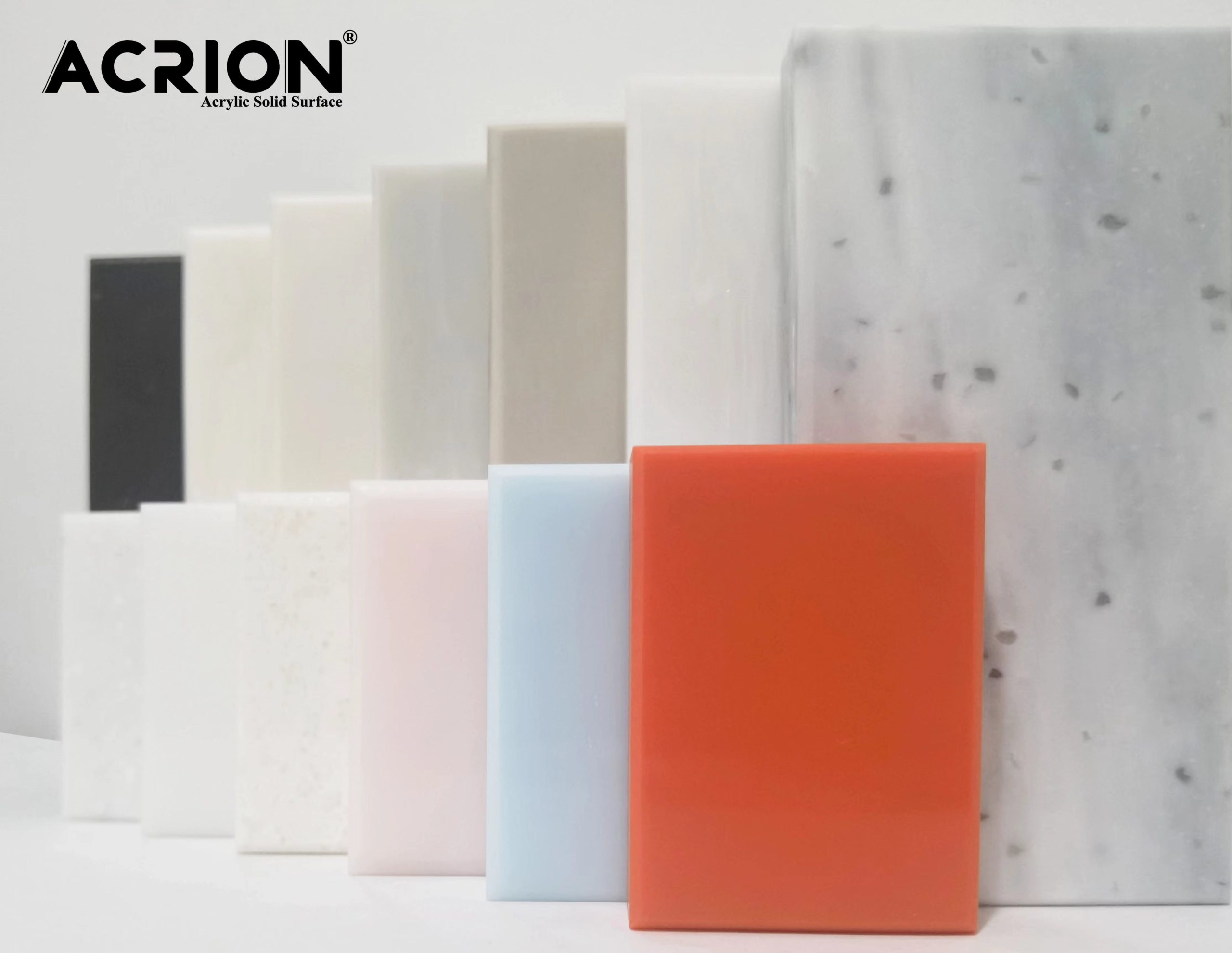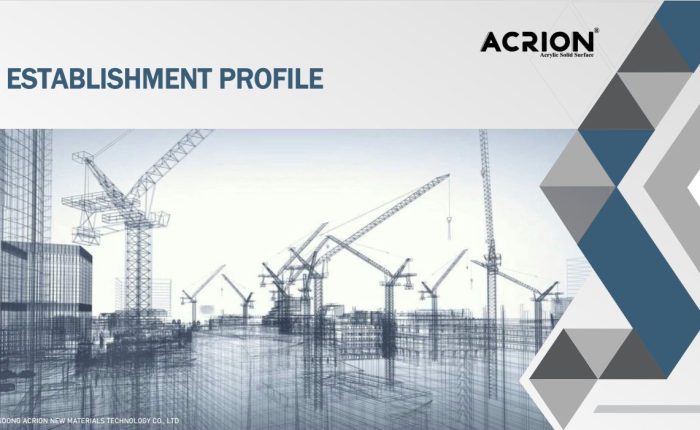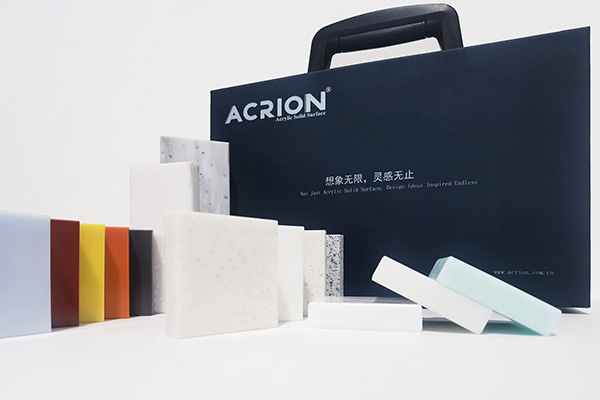กระบวนการเคลือบผิวสำหรับพื้นผิวที่เป็นของแข็งอะคริลิคนั้นเกี่ยวข้องกับขั้นตอนสำคัญหลายขั้นตอนโดยมีวัตถุประสงค์เพื่อให้แน่ใจว่าการเคลือบมีการยึดเกาะที่ดีความทนทานและความสวยงาม ต่อไปนี้เป็นกระบวนการทางเทคโนโลยีโดยละเอียด:
ก่อนการเตรียมการก่อนการก่อสร้าง
การรักษาวัสดุพื้นฐาน
การทำความสะอาด: พื้นผิวที่เป็นของแข็งของอะคริลิคจะต้องทำความสะอาดอย่างทั่วถึงเพื่อกำจัดคราบน้ำมันฝุ่นสิ่งสกปรก ฯลฯ เพื่อให้แน่ใจว่ามีพันธะที่ดีระหว่างการเคลือบและสารตั้งต้น
การบด: บดพื้นผิวปานกลางเพื่อเพิ่มความขรุขระและเพิ่มการยึดเกาะของการเคลือบ
การอบแห้ง: ตรวจสอบให้แน่ใจว่าพื้นผิวของสารตั้งต้นแห้งและปริมาณความชื้นควรเป็นไปตามข้อกำหนดสำหรับการเคลือบผิว
การเตรียมวัสดุ:
เลือกสีอะคริลิคที่เหมาะสมหรือไพรเมอร์ที่ตรงกันและเสื้อโค้ท
ตามข้อกำหนดการก่อสร้างให้เตรียมทินเนอร์ตัวแทนการบ่ม (ถ้าจำเป็น) เครื่องมือผสมเครื่องมือเคลือบ ฯลฯ
ประการที่สองแอปพลิเคชันไพรเมอร์
การเลือกไพรเมอร์:
เลือกไพรเมอร์อะคริลิคที่เหมาะสมตามลักษณะของสารตั้งต้นและข้อกำหนดของการเคลือบ ฟังก์ชั่นหลักของไพรเมอร์คือการเพิ่มการยึดเกาะระหว่างการเคลือบและสารตั้งต้นและปรับปรุงความทนทานของการเคลือบ
แอปพลิเคชันไพรเมอร์
เจือจางไพรเมอร์ในสัดส่วนที่กำหนด (ถ้าจำเป็น) และคนให้สม่ำเสมอ
ใช้เครื่องมือเช่นลูกกลิ้งแปรงหรือปืนพ่นเพื่อใช้ไพรเมอร์อย่างสม่ำเสมอบนพื้นผิวอะคริลิคที่เป็นของแข็ง
ตรวจสอบให้แน่ใจว่าไพรเมอร์ถูกนำไปใช้อย่างสม่ำเสมอโดยไม่มีพื้นที่ที่ไม่ได้รับหรือหย่อนคล้อย
หลังจากไพรเมอร์แห้งให้ทำการบำบัดการขัด (ถ้าจำเป็น) เพื่อกำจัดอนุภาคพื้นผิวเสี้ยน ฯลฯ
ประการที่สามแอปพลิเคชันการเคลือบระดับกลาง (ถ้าจำเป็น)
ฟังก์ชั่นของการเคลือบระดับกลาง:
การเคลือบระดับกลางสามารถเพิ่มความต้านทานการสึกหรอความต้านทานต่อแรงกระแทกและความเรียบของชั้นผิว
การก่อสร้างการเคลือบระดับกลาง
เจือจางวัสดุการเคลือบระดับกลางในสัดส่วนที่กำหนด (ถ้าจำเป็น) และคนให้สม่ำเสมอ
ใช้เครื่องมือเช่นเครื่องขูดและลูกกลิ้งเพื่อใช้การเคลือบระดับกลางบนชั้นไพรเมอร์อย่างสม่ำเสมอ
ตามข้อกำหนดการเคลือบระดับกลางหลายชั้นสามารถนำไปใช้เพื่อให้ได้ความหนาและความเรียบที่ต้องการ
หลังจากการเคลือบระดับกลางแต่ละครั้งจะถูกทำให้แห้ง
สี่แอปพลิเคชัน Topcoat
การเลือก Topcoat:
เลือกอะคริลิค topcoat ที่เหมาะสมตามสภาพแวดล้อมการใช้งานและข้อกำหนดด้านสุนทรียภาพ ฟังก์ชั่นหลักของ Topcoat คือการให้รูปลักษณ์ที่น่าสนใจและป้องกันการเคลือบ
แอปพลิเคชัน Topcoat
เจือจางเสื้อโค้ทในสัดส่วนที่กำหนด (ถ้าจำเป็น) และคนให้สม่ำเสมอ
ใช้เครื่องมือเช่นลูกกลิ้งแปรงหรือปืนพ่นเพื่อใช้ topcoat อย่างสม่ำเสมอบนเสื้อโค้ทกลาง (หรือชั้นไพรเมอร์)
ตรวจสอบให้แน่ใจว่ามีการใช้เสื้อบนยอดอย่างสม่ำเสมอโดยไม่มีพื้นที่ที่ไม่ได้รับการหย่อนคล้อยหรือเปลือกส้ม
ตามข้อกำหนดสามารถใช้เสื้อโค้ทหลายเสื้อโค้ทเพื่อให้ได้เอฟเฟกต์ลักษณะที่ต้องการและความหนาของการเคลือบ
ประการที่ห้าการอบแห้งและการบ่ม
การอบแห้งตามธรรมชาติ
ปล่อยให้การเคลือบแห้งตามธรรมชาติที่อุณหภูมิห้อง เวลาในการอบแห้งขึ้นอยู่กับปัจจัยต่าง ๆ เช่นความหนาของการเคลือบอุณหภูมิสิ่งแวดล้อมและความชื้น
การบ่มความร้อน (ถ้าจำเป็น):
สำหรับการเคลือบบางอย่างที่ต้องใช้การบ่มอย่างรวดเร็ววิธีการบ่มความร้อนสามารถนำมาใช้ ควรกำหนดอุณหภูมิและเวลาความร้อนตามข้อกำหนดของการเคลือบและลักษณะของสารบ่ม
หกการตรวจสอบและการยอมรับ
การตรวจสอบลักษณะ
ตรวจสอบว่าพื้นผิวของการเคลือบนั้นเรียบและแบนโดยปราศจากข้อบกพร่องเช่นฟองอากาศรอยแตกและการหย่อนคล้อย
ตรวจสอบว่าสีของการเคลือบนั้นมีความสม่ำเสมอและสม่ำเสมอและตรงตามข้อกำหนดการออกแบบหรือไม่
การตรวจสอบประสิทธิภาพ:
ตามข้อกำหนดการใช้งานการยึดเกาะความแข็งความต้านทานการสึกหรอความต้านทานต่อสภาพอากาศและคุณสมบัติอื่น ๆ ของการเคลือบจะถูกตรวจสอบ
การยอมรับ:
หลังจากผ่านการตรวจสอบโครงการจะได้รับการยอมรับและข้อมูลและวัสดุที่เกี่ยวข้องจะถูกบันทึก
เจ็ดข้อควรระวัง
สภาพแวดล้อมการก่อสร้าง
สภาพแวดล้อมการก่อสร้างควรสะอาดและแห้งเพื่อหลีกเลี่ยงการปนเปื้อนของการเคลือบด้วยฝุ่นคราบน้ำมัน ฯลฯ
อุณหภูมิการก่อสร้างและความชื้นควรเป็นไปตามข้อกำหนดของการเคลือบ ควรหลีกเลี่ยงการก่อสร้างในสภาพแวดล้อมที่อุณหภูมิสูงความคึกคักสูงหรืออุณหภูมิต่ำและสภาพแวดล้อมที่แห้ง
การป้องกันส่วนบุคคล:
คนงานก่อสร้างควรสวมใส่อุปกรณ์ป้องกันส่วนบุคคลเช่นชุดทำงานถุงมือและแว่นตาป้องกันเพื่อหลีกเลี่ยงการสัมผัสกับสีที่อาจทำให้ผิวและดวงตาระคายเคือง
การก่อสร้างที่ปลอดภัย
ควรตั้งค่าสัญญาณเตือนที่สถานที่ก่อสร้างเพื่อป้องกันไม่ให้บุคลากรที่ไม่ได้รับอนุญาตเข้ามา
ในระหว่างกระบวนการก่อสร้างควรให้ความสนใจกับมาตรการด้านความปลอดภัยเช่นการป้องกันอัคคีภัยและการป้องกันการระเบิด



